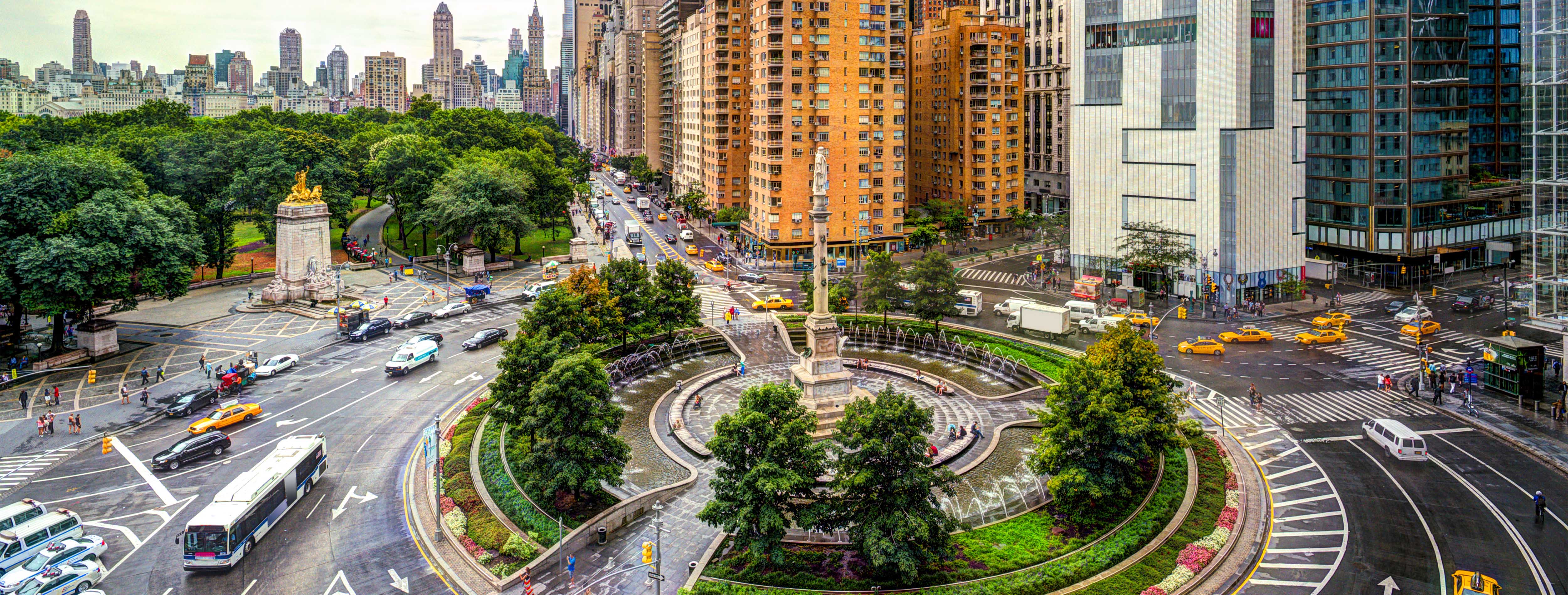Lincoln Center for the Performing Arts is not one building; it is a 16-acre complex comprising more than two dozen theaters, studios, and schools and is home to 11 arts organizations. And though its first building, now known as David Geffen Hall, opened only in 1962, Lincoln Center has become one of the best-known arts organizations in the world. Its main plaza—facing the Metropolitan Opera House, flanked by Geffen Hall and the David H. Koch Theater, with broad steps leading down to Columbus Avenue—has become a symbol of both the city and the arts.
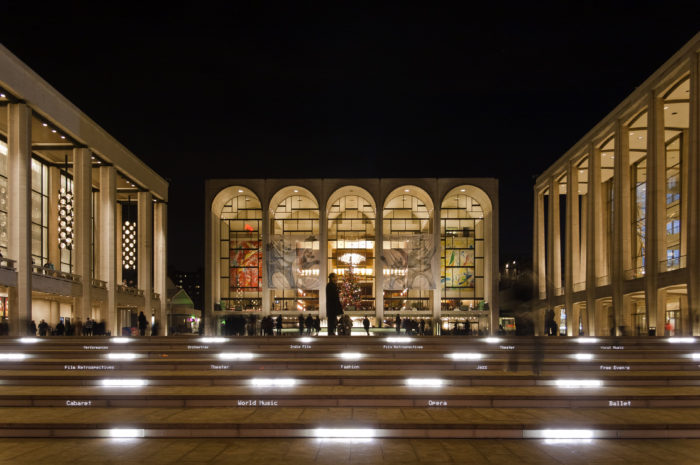
The steps leading up to Lincoln Center’s main plaza. The Koch Theater is on the left, the Met in the center, and Geffen Hall on the right. Image: Robert Mintzes/Wikimedia
Lincoln Center was a key aspect of the controversial Lincoln Square Renewal Project that began in the mid-1950s, spearheaded by the equally controversial builder and government advisor Robert Moses. Eighteen densely populated blocks were razed to accommodate the new construction; in the opening of the movie “West Side Story,” the Sharks are shown strutting and dancing among their remains.
President Dwight D. Eisenhower broke the ground for the new Lincoln Center in May 1959. The first of its buildings, Philharmonic Hall, opened on September 23, 1962. So momentous was this occasion, its opening-night concert, with Leonard Bernstein leading the New York Philharmonic, was televised live. The building on the north side of the main plaza, it was renamed Avery Fisher Hall in 1973, following the philanthropist’s donation of more than $10 million to the Philharmonic; in 2015 it was renamed once again, to David Geffen Hall, after the music mogul donated $100 million.
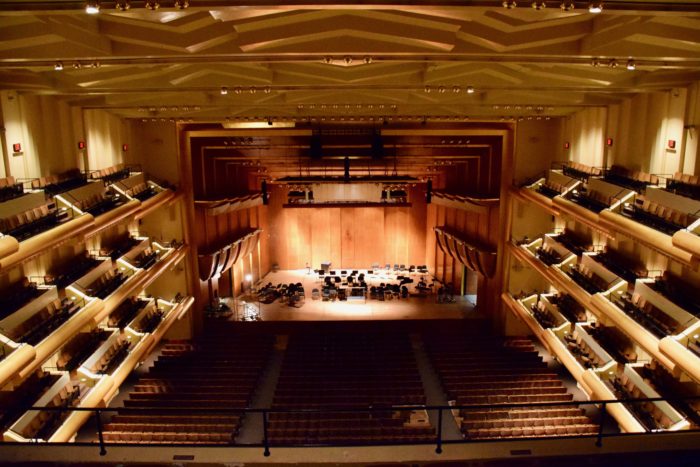
Inside David Geffen Hall. Image: Thomas J. Bickerton II/Wikimedia
The dramatic fountain of the main plaza—now known as the Josie Robertson Plaza, in honor of the wife of donor Julian Robertson—sprang to life in April 1964. With waters that can shoot up to 40 feet high, the fountain has featured in scores of movies and TV shows, including “Moonstruck” and “Black Swan.” Several weeks after the fountain’s official debut, the New York State Theater opened. The building on the opposite side of the fountain from Geffen Hall, the theater has been the home of the New York City Ballet ever since, and until 2011 it was home to the New York City Opera as well. In 2008 the building was renamed the David H. Koch Theater, following a promise by the oil billionaire to donate $100 million over 10 years.
The next building to open, in October 1965, is notable for several reasons. The Vivian Beaumont Theater is the only theater outside of the Broadway Theater District whose productions are eligible for Tony Awards. For instance, “War Horse,” which made its U.S. debut here in 2011, went on to win five Tonys, including Best Play. What’s more, the theater was one of the last buildings designed by the groundbreaking Finnish architect Eero Saarinen. James Earl Jones and Stacy Keach were among the cast of the theater’s opening production. Below the main theater—currently home to an acclaimed revival of “My Fair Lady”—are two smaller theaters. The Mitzi E. Newhouse Theater hosts off-Broadway-caliber plays and musicals, while the Claire Tow Theater, which opened in 2012, stages three or four productions by emerging talents each year.
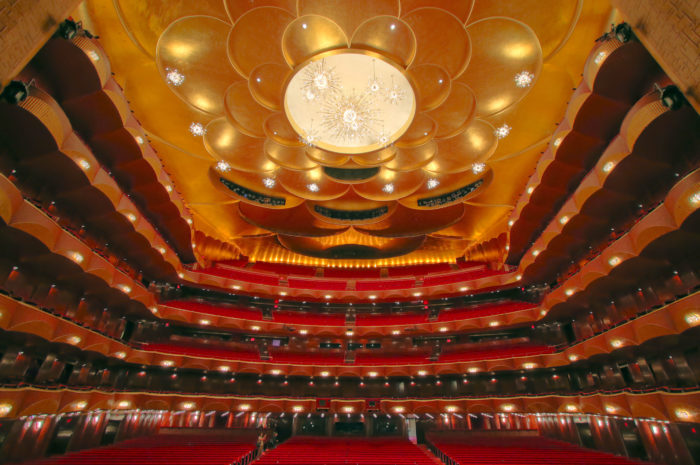
Inside the Met. Image: Professorcornbread/Wikimedia
The Metropolitan Opera House, the third of the buildings surrounding the Josie Robertson Plaza, opened in 1966 as the new home of the Metropolitan Opera Company, which had been located in a theater at Broadway and 39th Street since its founding in 1883. The Met, as it is commonly called, is also the spring/summer residence of the American Ballet Theater. Able to seat 3,800 audience members, it is the world’s largest repertory opera house.
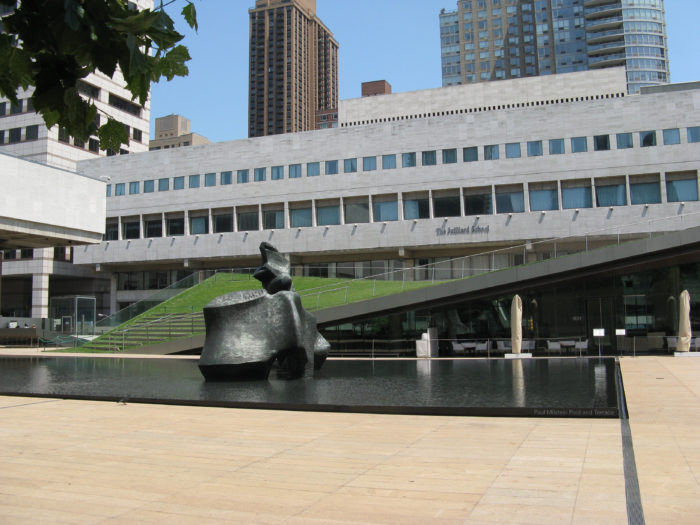
The Juilliard Building, with Henry Moore’s “Reclining Figure” in the reflecting pool in front. Image: Yair Haklai/Wikimedia
It would be another three years before the Juilliard Building opened. This Brutalist-style structure is, of course, home to the dauntingly competitive Juilliard School for the dance, music, and drama. Renée Fleming, Kelsey Grammer, Kevin Kline, James Levine, Laura Linney, Yo-Yo Ma, Bebe Neuwirth, Ving Rhames, and Robin Williams are just a few of the school’s alumni. Also in the building is Alice Tully Hall. The annual New York Film Festival is held here, and the theater is also the home of the Chamber Music Society of Lincoln Center.
The newest of the campus’s major structures, the Samuel B. and David Rose Building, opened in 1990. In addition to serving as the organization’s headquarters, it houses the School of American Ballet, Juilliard residences, the intimate Clark Studio Theater, and the Walter Reade Theater, home of the Film Society of Lincoln Center.
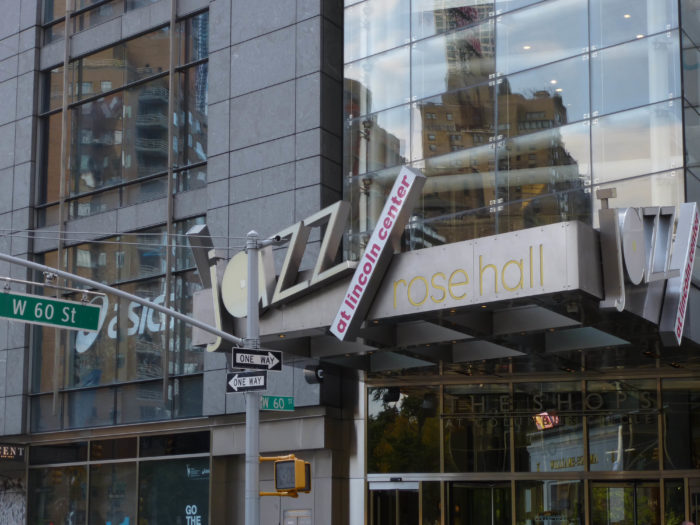
Jazz at Lincoln Center is based off the main campus, in the Time Warner Center. Image: Marianparedes/Wikimedia
Lincoln Center is the site of more than 3,000 performances and events each year. Regular series include American Songbook, a celebration of American songwriting held in the Appel Room of the Frederick P. Rose Hall, which is several blocks from the main Lincoln Center campus, in the Time Warner Center at Columbus Circle. Opened in 2004, this hall is home to Jazz at Lincoln Center, and its acoustics were designed specifically for jazz performances. In addition to the Appel Room, Rose Hall includes the larger Rose Theater and Dizzy’s Club Coca-Cola, a supper club with drinks, food, and an ever-changing roster of performers.
Another regular series, the summertime Mostly Mozart Festival, celebrated its 50th anniversary in 2016. It began as an event devoted exclusively to Mozart, but it has grown to include performances of works by Mozart contemporaries and those inspired by him. (Nearly every year includes a performance of Mozart’s Jupiter Symphony, however, which is not to be missed.) Also held in the summer, Midsummer Night’s Swing is an outdoor dance party, held at the center’s Damrosch Park, on the south side of the Met. Live bands play everything from mambo to disco, salsa to country music, for attendees to dance to. Outdoor concerts are held in the park as well.
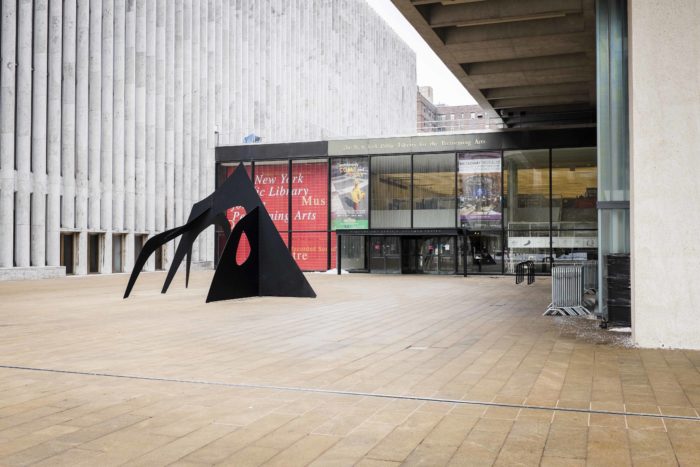
“Le Guichet” by Alexander Calder. Image: Billie Grace Ward/Flickr
While Lincoln Center is dedicated to the performing arts, the fine arts have a place here as well. Among the best-known pieces in its collection are two vibrant 36-foot-high paintings by Marc Chagall, “The Sources of Music” and “The Triumphs of Music.” Visible through the towering arched windows of the Met even as you climb the steps to the plaza, they have graced its lobby since the Met opened. Elsewhere in the Met hangs a Julian Schnabel portrait of tenor Plácido Domingo. A mobile by Kiki Smith titled “Overture” hangs over the bar in the Vivian Beaumont Theater. “Numbers, 1964,” the only public commissioned work by Jasper Johns, is among the artworks adorning the Koch Theater; in the upper left corner you can spy the footprint of choreographer and Johns friend Merce Cunningham. Also commissioned for Lincoln Center was “Reclining Figure,” a six-ton, two-piece bronze sculpture by Henry Moore, though the pool of water for which it was designed no longer exists; the work now resides in another pool on the Lincoln Center campus, between Geffen Hall and the Vivian Beaumont. And outside the Vivian Beaumont is “Le Guichet,” an abstract metal sculpture by Alexander Calder meant to evoke a ticket counter.
While Lincoln Center is home to dance, music, and theater companies, its campus, with its plazas and parks, fountains and reflecting pools, has become a destination even for those not attending a performance—and a distillation of New York culture at its finest.


